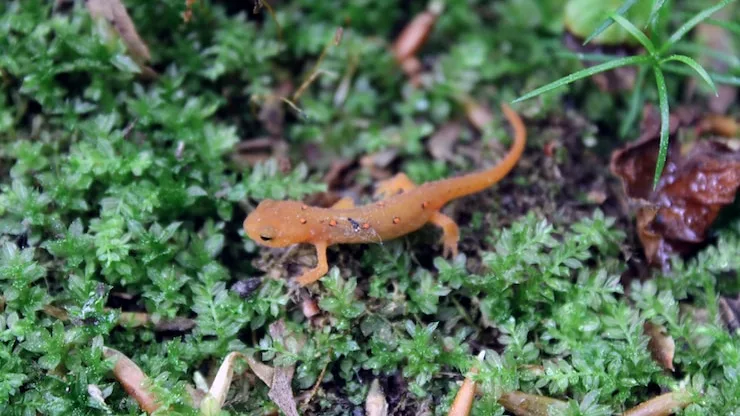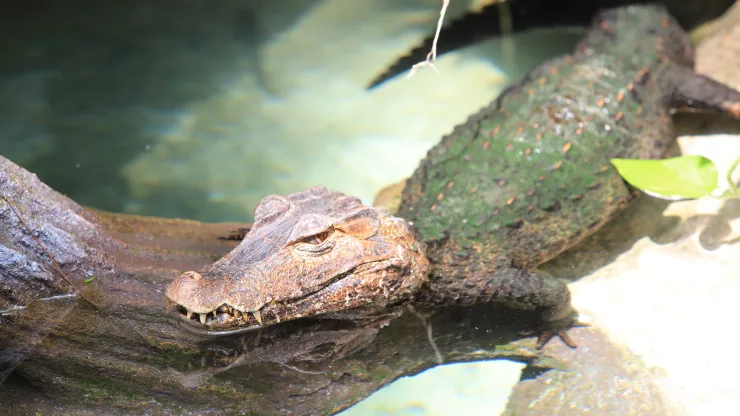Newts are fascinating amphibians that capture the hearts of many with their intriguing life cycles and diverse habitats.
These small, often brightly colored creatures belong to the family Salamandridae and are found in various regions across the globe.
With their distinctive features and behaviors, newts have become a subject of interest for both herpetologists and nature enthusiasts alike.
Let’s dive into the world of these remarkable animals and explore some of the most interesting facts about them.
Facts About Newts
- Dual Life: Most newts are known for their amphibious nature. They spend part of their life in water and part on land, undergoing a metamorphosis similar to frogs and toads. During their aquatic phase, they are equipped with gills for breathing underwater.
- Regeneration Abilities: Newts possess an incredible ability to regenerate lost body parts. They can regrow limbs, tails, eyes, and even parts of their hearts and brains, making them a subject of extensive scientific research in regenerative medicine.
- Toxic Defense: Many newt species secrete toxins through their skin as a defense mechanism against predators. The rough-skinned newt, for example, produces a potent neurotoxin called tetrodotoxin, which is also found in pufferfish.
- Vibrant Warning: The bright colors displayed by some newts are not just for show. These colors act as a warning sign to potential predators, signaling their toxicity and deterring attacks. This is known as aposematic coloration.
- Not Always Newts: The term “newt” typically refers to the terrestrial juvenile phase of these amphibians, while the aquatic adult is often called an “eft.” However, this nomenclature can vary among cultures and regions.
- Courtship Dances: Newts have elaborate courtship rituals. Males often perform a dance to attract females, which can include fanning their tails, touching, and releasing pheromones to entice the opposite sex.
- Lifespan Longevity: Newts can have surprisingly long lifespans for such small creatures. Some species can live for up to 20 years in the wild, and even longer in captivity with proper care.
- Diverse Diets: While aquatic newts primarily feast on small invertebrates like insect larvae, worms, and mollusks, terrestrial newts can capture a wider range of prey including slugs, snails, and even small amphibians.
- Environmental Indicators: Newts are sensitive to changes in their environment, making them excellent bioindicators. Scientists study changes in newt populations to monitor the health of ecosystems and detect pollution.
- Seasonal Changes: Many newts exhibit seasonal changes in behavior and physical appearance. In the breeding season, males often develop more vibrant colors and pronounced crests to attract females, while females might become plumper as they carry eggs.
In conclusion, newts are a group of amphibians with a wealth of intriguing characteristics.
From their regenerative capabilities to their role as environmental indicators, these creatures offer a glimpse into the complexities of nature’s adaptability.
Their importance in scientific research and their charismatic presence in their natural habitats underscore the need to understand and protect these remarkable animals.
FAQ
What is the difference between a newt and a salamander?
While all newts are salamanders, not all salamanders are newts.
Newts are a subgroup of salamanders that typically have an aquatic adult stage and a more defined metamorphosis cycle.
Salamanders, on the other hand, can have a wide range of habitats and life cycles, with some being entirely aquatic, entirely terrestrial, or amphibious like newts.
How do newts reproduce?
Newts reproduce through a process called internal fertilization. The male deposits a packet of sperm called a spermatophore, which the female then picks up with her cloaca.
She later lays fertilized eggs, often attaching them to aquatic plants.
Are newts easy to keep as pets?
Many newts can be kept as pets, but they require specific care to thrive.
This includes a suitable aquatic and terrestrial habitat, the right temperature, clean water, and a diet of live prey.
It’s important to research the particular needs of the species you’re interested in keeping.
Can newts survive outside of water?
Yes, many newts are amphibious and can survive on land for extended periods, especially during their terrestrial juvenile phase.
However, they typically return to water to breed and may spend more time in aquatic environments as adults.
What do newts eat?
Newts eat a variety of small invertebrates.
Aquatic newts hunt for prey like insect larvae, worms, and mollusks, while terrestrial newts might consume slugs, snails, and even small amphibians.
How do newts breathe?
Newts breathe in different ways throughout their life cycle. During their larval stage, they have gills for breathing underwater.
As they mature, they develop lungs and use their skin for gas exchange, allowing them to breathe on land as well as in water.
Are newts endangered?
Some newt species are indeed endangered or threatened, often due to habitat loss, pollution, and the introduction of non-native species.
Conservation efforts are in place for many of these species to protect their natural habitats and support their populations.
Do newts hibernate?
Yes, newts can hibernate during colder months. They often burrow into the mud at the bottom of ponds or find shelter in logs and leaf litter on land.
Hibernation allows them to conserve energy when temperatures are low and food is scarce.

I am a fun fact enthusiast and creator of Facts On Tap.
I love to share my knowledge and curiosity with readers and inspire them to learn something new every day.
When I’m not writing, I enjoy traveling, reading, and playing trivia games with my friends.




